Well bumper: device, options and do-it-yourself manufacturing schemes
The lack of a centralized water supply pushes residents of private houses to drill wells in their own areas. Agree, because without water in the house it is difficult to call a stay in it comfortable. But well drilling services are quite expensive. Well, at least there are devices that allow you to drill a well on the site on your own.
One of these devices is the bailer. This is an effective and relatively simple drilling tool for cleaning private water sources from bottom contamination. With its help, you can even drill a well quite suitable for operation by yourself. Such a hydraulic structure will require a minimum of funds. And even if it is done with one's own hands, the expenses will not in the least shake the family budget.
In this material we will talk about the device and the principle of operation of the bailer. We dwell in detail on what tools and materials will be required for its manufacture. In the article you will find step-by-step instructions for assembling the bailer, as well as videos that clearly demonstrate the device and the principle of operation of the bailer.
The content of the article:
The device and principle of operation
The flap is a rather heavy section of pipe with a length of about 1 - 2 m. At the bottom it is equipped with a valve, sometimes special pointed elements such as teeth are attached.
Pointy edge while drilling loosens the soil, silt, sand and other contents of the well, depending on the type of work. Lugs are welded from above to the pipe, in which a metal cable is fixed.
The upper section of the pipe is protected by a thick wire mesh. It will prevent the release of gravel, gravel or valve elements of the choke when they are torn off.
Most often, well cleaning from serious pollution. If well pump did not include for a long time, for example, several months during the winter period, a significant amount of silt or sand can accumulate in the well, depending on the soil.
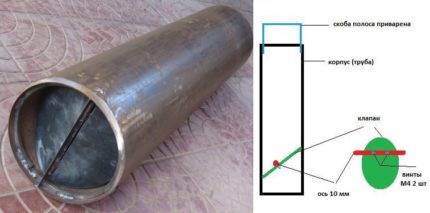
As a result of such silting or sanding, the production rate of the well is significantly reduced. In some cases, the pump even sucks in a layer of sludge, and it is far from always possible to free it and not damage it.
After the pump will be removed from the barrel, the well can be cleaned using a bailer.
The operation of the device is based on the gravitational principle. A heavy baulk is abruptly thrown into a well shaft from a great height. The pointed edges loosen the mass of dirt accumulated at the bottom. The valve opens, or sand fills the interior of the bailer. The valve closes and the filled baffle is lifted up.
To increase the efficiency of the device, the bailer is raised several times and thrown down. Thanks to the valve, the contents captured by it will remain inside.
Then the choke is pulled out of the well and freed from contamination. The cycle is repeated again and again until the well is completely cleaned.
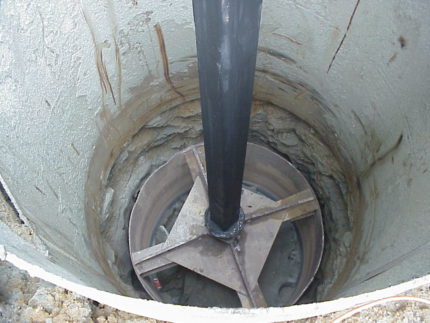
The baits are quite successfully used for well drilling in loose incoherent soils.
Well as a result of zhelonirovaniya turns out quite decent, suitable for productive operation. Of course, working with the bailer requires significant physical costs.
They can be reduced a little, for example, using a block or an electric winch to raise the filled bailer up.
Pipe for housing
So, to make the bouncer you will need:
- Pipe of suitable diameter.
- Valve.
- Welding machine.
- Metal cable
- Thick wire.
- Pieces of metal, etc.
To make the bailer yourself, first you need to choose a pipe of suitable diameter. In this case, you need to focus on the internal dimensions of the casing.
The distance between the outer wall of the chute and the walls of the shaft should be two centimeters. So, you need to subtract 40 mm from the inner diameter of the casing. This will be the value of the outer diameter of the pipe from which the bobbin will be made.

The size of the gap between the choke and the well may vary, but only to certain limits.
Too much clearance will reduce work efficiency. But if the gap is too narrow, the baffle may scratch or damage the barrel walls.
It is even worse if, due to the large diameter of the pipe, the bellow is stuck in the well, especially if the casing is slightly skewed. Removing it will not be easy, you can completely ruin the well and lose it.
The length of the pipe should also not be too short or long. A short device will often touch the walls when moving up and down. A too long element may turn out to be excessively heavy, it will be difficult to get it out, especially when the bellow is filled with a heavy blade.
The length of the pipe for the chipper is usually about 80 cm, but can vary between 60-150 cm. Longer and heavier devices are used for drilling.
The thickness of the pipe walls is also important, since the total weight of the product largely depends on it. The thicker, the more the tube weighs, and the more efficient the bellow will act.
But if drilling tool it will be too heavy, it will be difficult to work with it for the reasons already stated.A pipe thickness of 2-4 mm is considered sufficient, but it can reach 10 mm.
Thus, when choosing a pipe for the baffle, a certain balance must be observed. The weight of the device and its dimensions must satisfy two conditions.
Firstly, it is necessary to provide a sufficiently high piercing inertia so that contaminants are removed from the well quickly and efficiently. Secondly, the weight of the product with the load must be such that the baffle can be pulled out by hand or using a winch.
Valve systems for bobbin
The most difficult element of the bobbin is the valve. There are two main options: flap valve and ball valve. This element has one task: to let dirt or soil into the pipe and not allow it to spill out.
If the valve fits snugly, then the bailer will effectively capture not only dense impurities, but also water, which will increase the cleaning efficiency. But on some light soils, drilling can be done without a valve at all.
Option number 1 - design flap valve
The petal valve is easy to manufacture, but not too durable. It is an oval (ellipsoidal) plate of spring material: metal or polymer.
The valve is fixed in the center of the pipe. Under the influence of a stream of water, the edges of the ellipse open, passing the soil or silt inside the choke. For a more effective fit of the valve to the walls of the baffle, a rubber or leather seal is used.
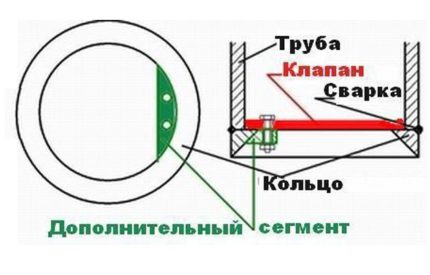
When lifting the flap with a flap valve, its “petals” are closed. But constant movements quickly wear out the valve, it simply fails.
Another variant of the flap valve is a valve on the spring, and closes with a fairly powerful spring.
The design is not complicated, it can be used both for cleaning a well and for drilling with a bailer. Craftsmen also come up with their own, quite effective valve options for the bailer.
Option number 2 - manufacturing a ball valve
The ball valve is a funnel, the mouth of which is tightly closed by a ball of the appropriate size.
The most difficult task in the manufacture of this valve is to get the right ball. It should close a rather large hole into which contaminated water will flow and be heavy enough to lower and close the valve reliably and quickly.
There are three options to get such a ball:
- just find it among the old scrap metal, for example, remove it from a large bearing;
- order the manufacture of the desired part from a turner who will carve the ball on the machine;
- independently make a ball using improvised means.
To make a ball yourself, you need to find a hollow plastic or rubber ball, such are sold in toy stores. A sufficient amount of lead shot should be purchased at a hunter store. In addition, you will need epoxy or any other waterproof glue.
A toy ball is cut in half. Each half is filled with a mixture of shot and glue. After drying, the halves must be glued and sanded, the ball is ready.
Instead of lead shot, any heavy metal balls, for example, taken out of old bearings, will do. You can also cast a ball of molten lead, but this process is a bit more complicated.
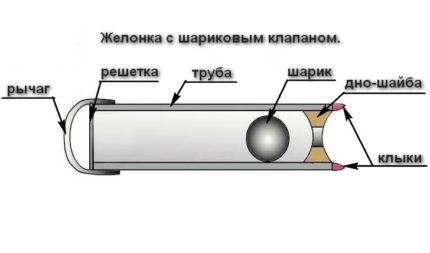
The size of the ball should be approximately 60-75% of the diameter of the well casing. The second part of the ball valve is a thick metal washer in which a funnel-shaped seat under the ball is cut out.Usually, a ball is first found or made, and then a washer of a suitable configuration is made.
For the ball, they grind a special “saddle” with an opening, which this ball closes. The valve opening must be large enough so that a lot of soil gets inside.
If this does not happen, the hole is bored as far as the diameter of the ball allows. If you decide to entrust the manufacture of the ball to a turner, then it makes sense to immediately order a saddle for him, i.e. whole valve.
If there is no welding machine
To make a solid and long-lasting bailer, you need a few metal parts weldand. If this is not possible, the simplest, but fully functional bailer can be made without it.
To do this, you can take a regular pipe with a length of about 0.6 m and a diameter of about 70 mm. Of course, it should be quite heavy. Top should attach a handle made of thick wire.

For this, two holes are drilled in the pipe walls, the wire is threaded through them and fixed. Below set a flap valve, which can be made from a regular plastic bottle. A two-liter capacity will do.
An appropriately sized valve in the shape of an ellipse is cut from its wall.
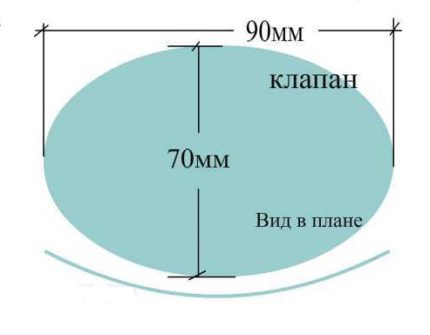
The smaller diameter of the valve should be equal to the inner diameter of the baffle, and to determine the larger diameter of the ellipse, another 20 mm is added to the diameter of the pipe.
The valve is fixed with a bolt 6-8 mm thick. The length of the bolt must exceed the outer diameter of the pipe so that it can be inserted across the pipe and fixed.
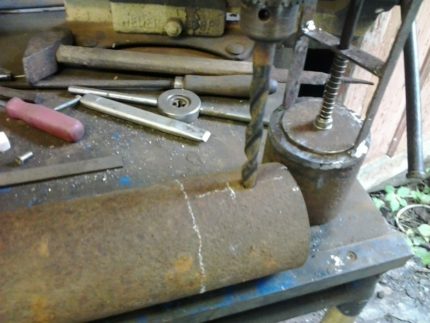
Those. the length of the bolt consists of the sum of the outer diameter of the choke and the thickness of the nut. But the bolt should not be too long so that it does not touch the walls of the casing.
Two bolts are drilled under the bolt in the walls of the chipper approximately 10 mm from the lower end of the chipper. To connect the valve to the bolt, use a 2-4 mm thick wire.
From it make two wire rings in the middle of the valve. The bolt should fit freely into these rings.
To assemble such a home-made bailer, you need to bend and insert a valve inside the bailer. Then the bolt is threaded into the hole in the pipe wall, then into the valve wire rings and again through the pipe wall. Fix the bolt with a nut.
The bolt must freely enter and be removed from the valve rings so that the bollard can be easily cleaned during operation.
Final assembly of the bobbin
If the pipe is selected, and the valve is ready and welded, it remains to perform a number of operations and recommendations to complete the production of the baffle. The bottom edge of the pipe should be sharpened so that during movement it gently removes impurities from the walls of the shaft.
Optimal will be one-sided sharpening from the inside.
It is recommended to heat-sharpen the edge so that it does not blunt so quickly when interacting with solid contaminants.
Sometimes pointed rods or pieces of metal are welded to the edge of the baffle to loosen dirt or soil. A loop is welded to the upper end of the pipe to secure the metal cable.

It can be made from pieces of thick metal wire. The loop must be welded in such a way that the bobbin suspended on the cable retains its vertical position.
This is very important, since distortions when moving the device inside the pipe are unacceptable.This can lead to jamming of the baffle or damage to the walls of the casing.
A reliable metal mesh is also welded at the top, which will prevent the ball from flying out of the choke when it moves down. Yes, and coarse soil better let them stay in the device. Instead of a metal mesh, you can make a wire grid. It remains to connect a metal cable to the bailer.
Sometimes a strong nylon cord is used instead. To make it easier to lower and raise the device, a slave is installed above the well with a block located directly above the well. The bobbin cable lead to this block.
As a result, the device sinks vertically into the well, and pulling it out is so much more convenient than just pulling the bailer up with your hands, like a bucket from a well.
Before lowering the assembled choke into the well, it is recommended to examine the walls of the shaft in order to take into account all irregularities and deformations. This will prevent damage or jamming of the baffle.
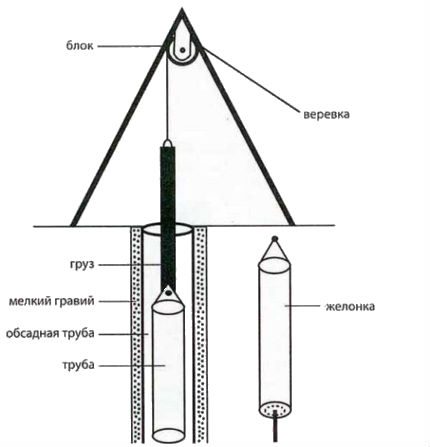
Pumping pattern with pump
It is very difficult to remove the baffle to clean the well, even with a winch. Significant time is spent not on working in the well, but on lifting, cleaning, and lowering the choke. A small upgrade will optimize the device. The back side of the body from the pipe should be tightly welded.
From it make a tap and put there a special fitting designed for a drain hose. A pump is connected to the hose, which is designed for pumping liquids with significant mechanical impurities.
Such a scheme makes it possible to abandon the constant rise of the flap to the surface and its repeated lowering.
In this case, contaminants from the choke chamber will be removed by the pump. The baffle equipped with a pump simply needs to be lifted and lowered to loosen and move the contaminated liquid into the chamber.
This cleaning method is effective for heavy silting or sanding. For normal cleaning of the well, a bailer without a pump is suitable.
Drilling Features
Drilling using a choke is a popular, albeit rather time-consuming, way to create a well. Not every device of this type, suitable for cleaning a well, can cope with the excavation of a large amount of dense soil. For drilling should use a fairly long choke - about four meters.
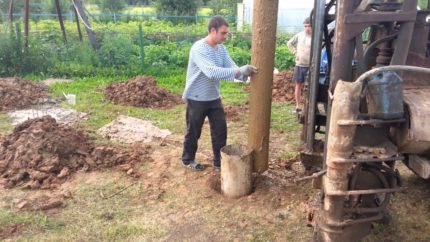
Here, a variation of the flap valve is more appropriate, which is a plate that is fixed with a special spring. With its help, a lumen is created in the body, the area of which is almost equal to the cut-off area of the flap. This allows you to let the maximum amount of soil per dive into the bobbin body.
It is not always easy to remove dense soil from a long and narrow flap. To simplify this task, a special window is made in the upper part of the pipe, designed for more efficient and faster cleaning of the device. If sandy rocks are to be drilled, it will be easier to free the bellow.
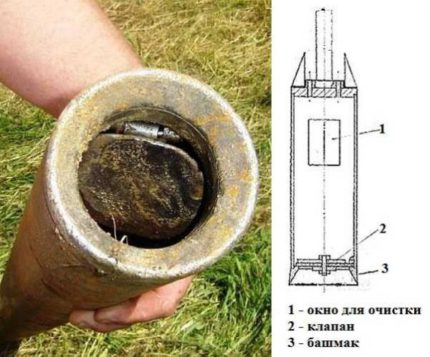
When drilling a bailer of different types of rocks, there are some peculiarities. Here are some helpful suggestions:
- On sandy soils, do not submerge the bellow more than 10 cm without the casing. In general, the casing is 10 cm ahead of the bailer.
- When drilling sandy soil, water is supplied to the trunk to further strengthen the walls.
- If wet sand is excessively compacted during work and does not get into the choke, use a special chisel.
- The casing is immersed during drilling continuously.
- For quicksand use a bailer with a length of two meters or more with a reliable flat valve and leather seal.
- Raising the bailer in the quicksand, it is necessary not only to lower the casing, but also to crank it, it is more convenient to carry out this work together or three.
- If the casing is not included in the shaft, it is lowered under pressure, for which they put a platform on top of which the cargo is placed.
- When drilling layers of gravel and pebbles, the use of a chisel, which breaks large inclusions, and a bailer for excavating broken soil are sometimes alternated.
- On dense sediments, the bellow is raised only by 10-15 centimeters, and often make movements.
- When driving tight formations, the casing is buried hydraulically or someone periodically stands on the site installed on the casing.
- Dry layers are softened by feeding water to the shaft.
- On very soft plastic soils, the valve is not always needed, the rock remains in the bailer and without it.
- The baffle must be raised after driving every 0.5 - 0.7 m, so as not to tear when lifting the body filled to the limit.
As with other drilling methods, using a bailer, it is necessary to take into account the individual characteristics of the soil on which work is performed.
The right strategy and timely casing of the barrel walls usually allows you to successfully create a working well.
You may also be interested in information on how to flush the well after drilling.
Conclusions and useful video on the topic
One of the options for manufacturing a flap valve for the baffle is presented in the following video:
You can get acquainted with the device and the principle of operation of the ball valve for the baffle in this video:
Here you can consider the design of the chisel designed for drilling:
Self-made bobbin is not a particularly difficult task. This device can be made taking into account the specific needs of your site and the opportunities that are available. A simple design will ensure the long life of the bailer, if it is made with high quality.
If you have experience in the independent manufacture and use of bailers, please share it with our readers. Leave your comments in the box below.

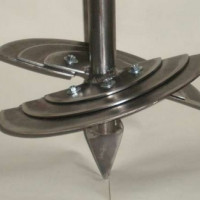 How to make a drill for a well with your own hands: the best homemade schemes
How to make a drill for a well with your own hands: the best homemade schemes 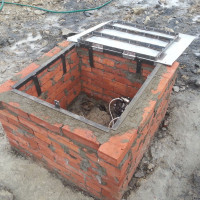 How to make a caisson for a well with your own hands: device options and methods for their implementation
How to make a caisson for a well with your own hands: device options and methods for their implementation  Do-it-yourself well cleaning: a review of common clogging causes and best cleaning methods
Do-it-yourself well cleaning: a review of common clogging causes and best cleaning methods 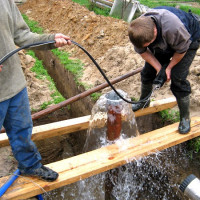 Do-it-yourself flushing of the well after drilling: step-by-step briefing on the work
Do-it-yourself flushing of the well after drilling: step-by-step briefing on the work  Do-it-yourself well without equipment: how to independently arrange a water source
Do-it-yourself well without equipment: how to independently arrange a water source  How to make a do-it-yourself filter for a well: an overview of the best home-made options
How to make a do-it-yourself filter for a well: an overview of the best home-made options  How much does it cost to connect gas to a private house: the price of organizing gas supply
How much does it cost to connect gas to a private house: the price of organizing gas supply  The best washing machines with dryer: model rating and customer tips
The best washing machines with dryer: model rating and customer tips  What is the color temperature of light and the nuances of choosing the temperature of the lamps to suit your needs
What is the color temperature of light and the nuances of choosing the temperature of the lamps to suit your needs  Replacement of a geyser in an apartment: replacement paperwork + basic norms and requirements
Replacement of a geyser in an apartment: replacement paperwork + basic norms and requirements